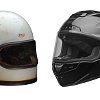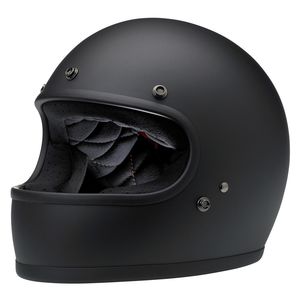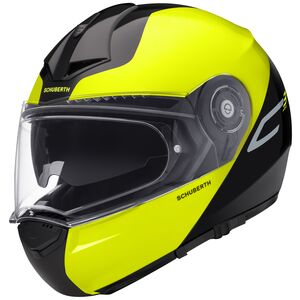A helmet is your most important piece of motorcycle gear and today you can get a helmet made specifically for the kind of riding you do, whether you're racing motocross, crossing the continent on the slab or commuting to work.
Street riders who want a lot of protection and maybe some extra convenience often find themselves choosing between a modular and a full-face helmet. These two kinds of street motorcycle helmets are similar in many ways, but they each offer advantages and disadvantages compared to the other. Here's what you need to know to make the right choice for you.
Full-face motorcycle helmets
Bell introduced the first full-face helmet, the Bell Star, into the motorcycle world back in 1966, but it wasn’t until 1975 when the first full-face helmet with a flip-up visor was introduced, the Bell Star II. Thankfully, helmets have come a long way since the 1960s, and that's a good thing, since the cars have gotten taller and the drivers more distracted since then.

A full-face helmet is designed to cover the user's entire head and therefore it will provide the best level of protection. Before Bell invented the full-face helmet, everyone wore the open-face design, which of course leaves you vulnerable to some nasty injuries if you crash and happen to fall face down. Thankfully, today's full-face helmets have hinged face shields that open and close and allow you to get some fresh air while stopped at a light on a hot day. You can still get a modern helmet that carries on some of the style of that original Bell. Just look at the Biltwell Gringo for a great example of a retro-styled lid with a modern twist. The Gringo S adds the benefit of a face shield.
Because they provide the most protection, full-face helmets are typically a requirement if you plan to be on two wheels on a race track, and that holds true whether you’re at the motocross track or on a beautifully paved tarmac road course. (Of course there's always an exception, and in this case it's the vintage racing my buddy Zito enjoys doing.)
Track day organizations may also require you to wear a helmet with a SNELL or ECE certification. You’ll find a few modular lids with an ECE certification but not with a SNELL certification, because the chinbar on modular helmets creates a weak point and therefore it will not pass the required testing.

So if you are going to the track or simply want the maximum protection on the street, a full-face helmet is the ticket. They also tend to be lighter and more quiet than a modular helmet, within their respective price points. Of course, I’ve used expensive modular helmets that were quieter than inexpensive full-face lids, but the general rule holds true. We'll talk more about the subject of noise later.
Modular motorcycle helmets
A modular helmet incorporates a hinge system that allows the chinbar to easily lift open with a simple touch of a button. This action, more or less, transforms the lid into an open-face helmet for convenience, but with the chinbar closed you’ve essentially got a full-face helmet. The original intent of the modular design was increased comfort and convenience and making it easier for riders to communicate at traffic lights or during quick stops without having to remove their helmets. Today, we have a plethora of Bluetooth communication systems to help us with the communication part, but if you want to gulp down some water at a gas stop, a modular helmet makes it easy while a full-face helmet makes it likely you'll pour water down your chest.
There's another factor that some riders may not think of. During my days as a Gear Geek here at RevZilla, I spoke to many riders who simply preferred a modular helmet because they felt incredibly claustrophobic when wearing a full-face lid. They liked being able to open the chinbar quickly and easily if they ever needed to. Trust me, it’s a thing.

Internal sun visors are another benefit you’ll find in some modular helmets that's not quite as common in full-face helmets. The sun visor is like sunglasses built into the helmet that you flip down when needed. Again, it's about convenience. With most full-face helmets, you have to switch from a clear visor to a tinted one to get sun protection.
Manufacturers generally warn you not to ride with the modular helmet open. I'm not going to tell you I've never ridden around the corner at slow city speeds with mine in the up position, but I will tell you that if you’re riding at highway speeds and you try to open the chinbar, it’s probably not going to go very well. Wind can grab the chinbar much like a sail on a boat and pull and yank your head around. I’ve experienced it and it’s not great.
With that said, there there’s always an exception. Shark has a few modular helmets in their line with a very unique design that allows the chinbar to open and rotate to the back of the helmet. When the chinbar is rotated to the back, it locks into place and allows the user to easily ride with the helmet in the open position. You can also find a similar design with the LS2 Valiant Helmets.
Drawbacks of modular motorcycle helmets
Along with the additional versatility modular helmets provide, there are a few cons. They tend to be a bit heavier in comparison to most full-face helmets. The hinge system and commonly included internal sun visor add weight. Furthermore, modular helmets typically have a larger overall shell size when compared to full-face lids, and that also contributes to the additional weight.
In terms of safety, full-face helmets with their one-piece shell provide the most protection, without the weak point of the rotating chinbar on modular helmets. I certainly consider modular helmets to be safe, but I still feel a full-face helmet is the safest.
Outside of weight and safety, perceived noise is also always a hot topic of discussion when comparing modular helmets and full-face helmets. With either option, when it comes to noise, there’s a lot to consider.

What's the quietest modular helmet?
Customers often ask "What is the quietest modular helmet?" It's a reasonable question because wind noise can have a significant impact on rider fatigue. Noise levels are a very common concern and certainly something I take into consideration with any new lid, full-face or modular.
Here’s the rub. I’ve said it many times and I’ll say it again — perceived wind noise levels are highly subjective and there are several factors that can lead to dramatically different results from one rider to the next.
Does your helmet fit properly? If it's too loose, it will allow more wind to move throughout the helmet, increasing noise. What motorcycle are you riding? A touring bike with a large windscreen will provide more protection and make the helmet seem quieter than if you test that same lid on a different bike without the aforementioned windscreen. Also, Spurgeon and I can ride the same Harley-Davidson Street Glide with the same helmet on and have two totally different experiences because the fairing is too short for his six-foot, four-inch height but is just fine for me.
With all of that in mind, there are a few modular helmets that have earned a reputation for being on the quiet side of the scale. For starters, Schuberth is not only known for premium German engineering but also for doing a lot of wind tunnel testing R&D to keep noise levels low. Shoei’s Neotec 2 is another great option that has won a lot of positive feedback and, generally speaking, gets praise for its reduced noise levels when compared to other modular helmets.
For something a bit more economically priced, I’d check out the HJC IS-Max 2. You’ve got an internal sun visor, Pinlock-ready shield, speaker pockets — it’s a great option at that price point.
Which is better, modular or full-face?
The answer to this question will be different from one rider to another. In my opinion, I would say a full-face helmet is better 80 percent of the time. If someone says, “My modular helmet is a life saver. I live in Arizona and often find myself in stop-and-go traffic commuting to work while it’s 100 degrees out,” I will completely agree with the aforementioned rider and hope to goodness I have a modular helmet for those riding conditions, too.
It's not just about comfort, either. Convenience is a major draw for modular helmets. Sure, you can crack the shield on a full-face helmet and increase your airflow, but you can’t easily take slurps from a Big Gulp and eat some pizza while wearing a full-face helmet.

Ultimately, it’s not really about which one is better. It’s about which one is better for you. I think this holds true for pretty much all riding gear. What's perfect for me and the way I ride may not be the right choice for your riding experience.
Understand what you value most from a street motorcycle helmet and that will lead you in your decision between a modular or full-face design.





















